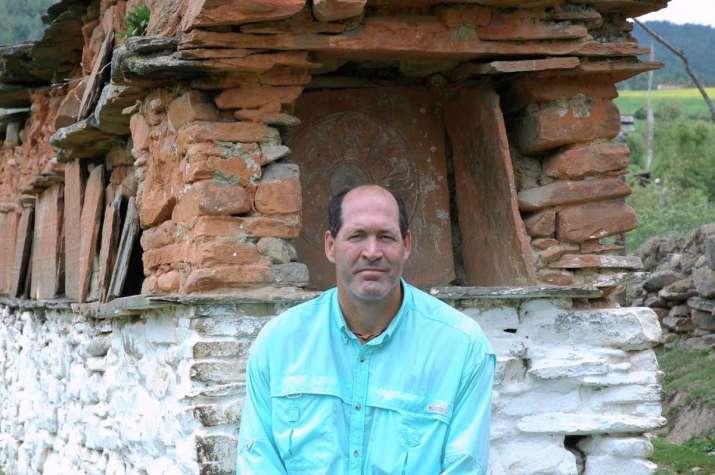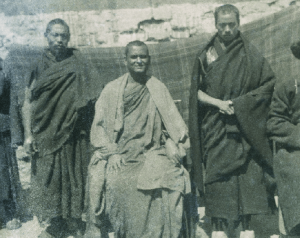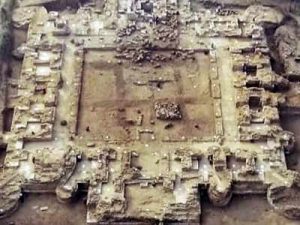
Twelve years ago, Mike Borre, a 45-year-old American former athlete with early-onset Parkinson’s disease, traveled to Bhutan with Core of Culture’s dance research team to act as a “test subject” in encounters with six different traditional healers. The results were surprising and clear. Last month, Part One of this story, “Everyone with a Cow Owes Me a Favor,” detailed one of the most extraordinary encounters, dramatic and effective, when Mike, the American athlete, met the former Je Khenpo, or supreme patriarch of all Buddhist monks in Bhutan. The Je Khenpo was also known as the Nizer Tulku, and was a double reincarnate: the return of a healer of trembling diseases as well as the founder of a revealed dance lineage, Woogpa Lingpa.
What we noticed only after that highly charged month was completed was that Mike had been ritually attuned to receive the powerful healing from the Nizer Tulku. Two encounters had prepared Mike in advance of his meeting the Nizer Tulku—one with a two-man team of Aryuvedic therapists in New Delhi, and another with traditional Buddhist healer Lam Yeshe in Bhutan—known for healing Parkinson’s disease in several people. This article will describe the Ayurvedic treatment, while Part Three next month will examine the meeting with Lam Yeshe. Following that, the final episode will detail Mike’s encounter with an oracle who traveled to connect with the ancient Tibetan king Gesar.
Mike died in an accident 10 years ago, the passenger in a car struck by an out-of-control driver on an icy highway. We were friends before this healing expedition in Bhutan, and subsequently became closer friends, delving into the dark corners of the psyche of illness, and making sense of life throughout these encounters. Mike said something profound near the end of his trip: “No one has Parkinson’s alone. If you are married, and your wife doesn’t leave you, your marriage has Parkinson’s. Your parenting has Parkinson’s. It affects every relationship you have. If you don’t lose your job, your employment has Parkinson’s. It is humbling. My family’s love was amazing.”
“Now I see myself healed in so many ways after a month in Bhutan. Did one person do it? I sure didn’t do it alone. Everyone in Bhutan did it. Bhutan’s affection for me was amazing. All the healers healed me. Bhutanese kindness healed me. My being open to this great spiritual journey healed me.”
Sequentially, the process of his healing encounters began at the glitzy Taj Hotel in New Delhi, where the finest Ayurvedic therapists can be found. The masseurs, Kerala-trained Bawa and Hnawda, knew me from earlier trips. I explained the situation with Mike and sought their advice on an initial therapy. After consulting with the resident Aryurvedic doctor, Dr. K. B. Vinod, they recommended a two-man Aryurvedic massage on a stone table, using particular oils, and lasting two hours. I was present to chronicle the treatment and any change in Mike.
Of some concern was Mike’s pacemaker, installed in his heart and connected to his brain, where the heart’s rhythm was intended to activate a deep-brain stimulator to the hypothalamus gland, stimulating dopamine production. We didn’t understand right away what they meant when they called the treatment “a rhythm treatment.” They asked Mike to shut off his pacemaker, which he could do anytime, and he happily complied. He was taking Parkinson’s medication daily, which reduced but did not eliminate his tremors, and which also made his head foggy. He hated them. He did not take any drugs on the day of the Ayurvedic treatment. The oils used by the healers on his body were spelled out for us thus: Ohanwas Lharom Thailens and Kottom Chukadi Thailens. The oil used on his head was Sadbabala Thailens.
From the start, it was obvious that this was not Western medicine. Mike stripped down and was given a traditional loincloth to wear, then seated on the stone table. The treatment begins by honoring the patient, washing his feet, anointing him with oils, and using flowers, incense and bells as the healers, ritually purified adepts, chanted the divine intention of benign effect and offered Mike’s purpose in life. Mike’s goal, if he dared to speak it, was not to be “healed,” but rather more modestly to avoid needing a second surgical implant in his brain to control the other half of his body. He was feeling, in his words, a bit “Frankensteinian.” The top of his skull had been removed for the surgery, performed while Mike was conscious. The Ayurvedic therapists were not the only healers who considered Western treatments to be little short of barbarism.
The treatment was given in two parts: first with Mike lying on his front, and then lying on his back. After 45 minutes of treatment applied to his back by both men working in complete synchrony, the tremors in his left hand and right foot subsided completely. The second half of the treatment had Mike lying on his back. A beautiful bronze bowl with a hole in the bottom was suspended above his head, and a slow, continual pour of oil fell to his forehead, head, brow, and scalp for 30 minutes. This treatment focused on his head exclusively.
For the concluding 45 minutes, all the while, the two men, in rapid synchronized rhythm, made long, full body strokes from foot to torso to fingertips; again and again, oil dripping over and into his body, ceaseless energized healing movements, dazzling rhythms as the masseurs made a series of various strokes down his arms, his legs, his torso. By the end of this highly physical, powerfully energetic treatment, the masseurs themselves were exhausted. Like qi gong, reiki, and other Asian therapeutic arts, the Aryuvedic healers could transmit and control their own energies.
The collateral effects of Parkinson’s include constant strain on the skin and constant flexion of the muscles. The entire muscular-skeletal system is engaged in a non-stop domino effect of compensatory adjustment in order to execute the most mundane daily activities. The basic human rhythms of heartbeat and breathing are tied up in a complex of erratic, uncontrolled palsies and contractions. The cessation of his body tremors remained throughout the 75-minute continuation of his treatment, and during the return trip to our hotel and until 9pm that evening when he went to bed.
Mike thanked the masseurs sincerely and asked how it was that his tremors had stopped and stayed that way. They smiled and said, “Your mind and breath are connected and controlled now. We restored you to your natural rhythms.” They did not prescribe any course of treatment for Mike, leaving the session ending as it was: a testimony to possibility, no better beginning for a healing odyssey.
This intensely physical treatment paved the way for what was to come: a sequence of spiritual healings at the hands of the Bhutanese Lam Yeshe, readying him for his great encounter with the Nizer Tulku, who was his teacher in tantric healing arts. None of us understood this until much later, as so many of our plans were determined by chance. Five years later, Bawa, one of the Ayurvedic therapists, delivered all of our research field notes on Mike’s six experiences to the Ayurvedic university where they were trained, adding to existing research and benefitting many others.
This article is dedicated to the memory of Mike Borre.
See more












